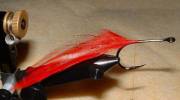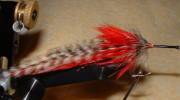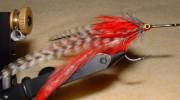
Lemays Big Eye Tarpon Fly by Jason Akl
article copyright
No matter what name you call them by Tarpon, are the undisputed kings of inshore fishing in warmer waters. The awesome power, exhaustingly long runs and unbelievable aerobatics make chasing these Silver Kings one of the ultimate challenges for a fly fisherman. Whether it be sight casting to big cruising fish or blind casting in a mangrove channel, hooking up with tarpon comes down to one thing, having the right fly on at the right time. Tarpon are very cunning fish and will only respond to flies that they like.
Captain Bob Lemay’s big eye tarpon fly is one of those flies that tarpon just always seem to be in the mood for. The long slim profile coupled to the undulating action of this fly make tarpon go wild. But just because you hooked into a tarpon doesn’t mean you will get him in. Tarpon are notorious for throwing hooks on one of their many aerobatic jumps and that’s the main reason for incorporating a super sharp TMC saltwater hook into this pattern.
Lemay’s big eye tarpon fly comes in a wide variety of colors that can be fished throughout the many different water conditions you might encounter on your next fishing trip. As a rule-of-thumb, bright colors are best when used with clearer waters while the darker colored patterns are best for stained or dark water conditions. This is, of course just a general rule. There are certainly times when fish prefer feeding on a dark fly in clear conditions or a brighter fly in stained waters. It is a good idea to carry a few different colors of Lemay’s big eye tarpon fly to best suit any water conditions you might come across and give yourself the best chance at hooking up with that monster sliver king you have dreaming about.
Materials Used for the Big Eye Tarpon Fly
Hook: Daiichi Curved shank Size 1/0
Thread: Uni-thread Red 6/0
Tail: Grizzly Hackles/ Red Hackles
Body: Palmered Grizzly Hackle/ Palmer Red Hackle
Head: 5 minute Epoxy/ Paint
 1. Start this fly by placing the hook into the vice securely and attaching the thread behind the hook eye. Cut 4 strands of red crystal flash and tie them onto the hook shank at the point above the barb. Fold the tag ends over the back of the fly and tie them in place to make a tail of 8 strands of krystal flash. Select 2 red saddle hackles and strip the fuzz off of the bottom of the hackle. Tie the hackle onto the sides of the fly so that the feather curvatures face outwards.
1. Start this fly by placing the hook into the vice securely and attaching the thread behind the hook eye. Cut 4 strands of red crystal flash and tie them onto the hook shank at the point above the barb. Fold the tag ends over the back of the fly and tie them in place to make a tail of 8 strands of krystal flash. Select 2 red saddle hackles and strip the fuzz off of the bottom of the hackle. Tie the hackle onto the sides of the fly so that the feather curvatures face outwards.
 2. Repeat this process with grizzly hackles so that now you have a grizzly and red hackle pair on each side of the fly. Take another red saddle hackle and tie it in by its tip in front of the tail you just created. Palmer this hackle for carefully building a collar for the fly. Be careful not to wrap down any of the previous hackle wraps with each new successive wrap of hackle. Once again palmers a hackle up the hook shank but this time use a grizzly hackle. After the hackle is formed pull the collar fibers backwards slightly and take a few of thread over the collar base to create a swept look. Build a small neat head and whip finish the thread.
2. Repeat this process with grizzly hackles so that now you have a grizzly and red hackle pair on each side of the fly. Take another red saddle hackle and tie it in by its tip in front of the tail you just created. Palmer this hackle for carefully building a collar for the fly. Be careful not to wrap down any of the previous hackle wraps with each new successive wrap of hackle. Once again palmers a hackle up the hook shank but this time use a grizzly hackle. After the hackle is formed pull the collar fibers backwards slightly and take a few of thread over the collar base to create a swept look. Build a small neat head and whip finish the thread.
 3. Add a drop or two of 5 minute epoxy and place the fly on your epoxy drier. Once the head has dried take you paints and place one eye on each side of the head. Adding a final coat of head cement the head will help with the durability of the paint when fishing the fly.
3. Add a drop or two of 5 minute epoxy and place the fly on your epoxy drier. Once the head has dried take you paints and place one eye on each side of the head. Adding a final coat of head cement the head will help with the durability of the paint when fishing the fly.
author website: visit | author bio
![]()

